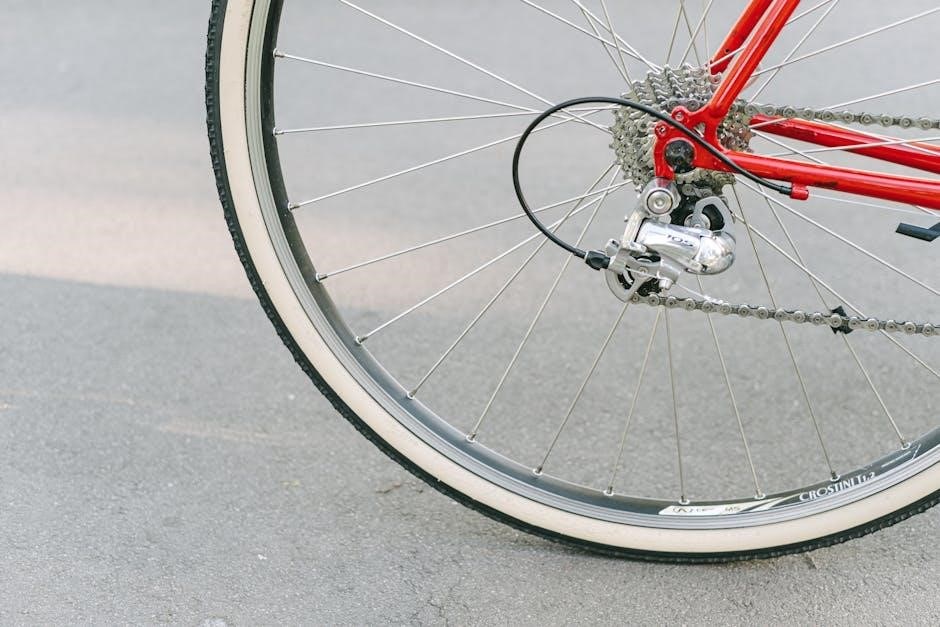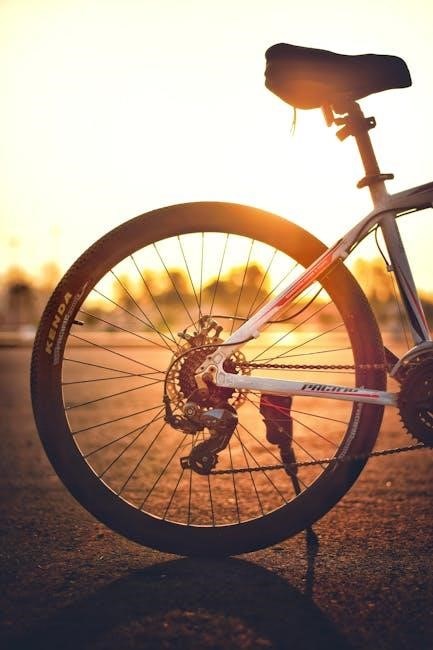Understanding bike tire width is crucial for performance, comfort, and control. This guide explores how width impacts speed, traction, and handling across road, mountain, and gravel bikes, offering expert insights and practical tips for optimal tire selection.
1.1 Importance of Tire Width for Performance
Tire width significantly impacts a bike’s performance, affecting speed, comfort, and control. Wider tires offer better traction and stability, especially on uneven terrain, while narrower tires enhance speed on smooth surfaces. The right width balances rolling resistance and handling, ensuring optimal efficiency. For road bikes, wider tires improve comfort without sacrificing much speed, while mountain bikes benefit from aggressive tread on wider tires for better grip. Proper tire width selection is crucial for maximizing performance across various riding conditions and bike types.
1.2 Brief Overview of Tire Width Options
Bike tire widths vary significantly, catering to different riding styles and terrains. Road bikes often use narrower tires (20-28mm) for speed, while mountain bikes utilize wider options (2.0-2.5 inches) for traction. Gravel and cyclocross bikes fall in between, offering versatility with widths around 30-45mm. Commuter and hybrid bikes typically use medium widths (28-42mm) for practicality. Each width range is designed to optimize performance, comfort, and control, ensuring riders can choose the best fit for their specific needs and preferences.

Understanding Bike Tire Width Measurements
Bike tire width is measured in millimeters or inches, reflecting the tire’s diameter. This measurement impacts performance, comfort, and control, ensuring the right balance for every ride.
2.1 How Tire Width is Measured
Tire width is measured across the tread from one sidewall to the other, typically in millimeters or inches. This measurement determines the tire’s compatibility with rims and frames, ensuring proper fitment. Accurate measurements are crucial for performance, as they affect handling, comfort, and speed. Always refer to the sidewall for specifications, as width can vary slightly when inflated. Proper measurement ensures optimal tire function and safety, making it a key factor in selecting the right tires for your bike.
2.2 Standard Tire Width Ranges for Different Bikes
Standard tire widths vary by bike type. Road bikes typically use 23-28mm tires for speed, while mountain bikes range from 2.0-2.5 inches for traction. Gravel and cyclocross bikes often use 35-50mm tires for versatility. Commuter and hybrid bikes may use 1.5-2.0 inches for practicality. These ranges ensure optimal performance, comfort, and control for specific riding conditions. Understanding these standards helps cyclists choose tires that match their bike’s intended use and terrain, enhancing overall riding efficiency and enjoyment.
Factors Influencing Tire Width Choice
Bike type, rider weight, and terrain significantly influence tire width selection. Wider tires offer better comfort and traction, while narrower tires enhance speed and efficiency on smooth surfaces.
3.1 Bike Type and Its Impact on Tire Width
The type of bike significantly influences tire width; Road bikes typically use narrower tires (23-28mm) for speed and efficiency, while mountain bikes require wider tires (2.0″-2.5″) for traction on rough terrain. Gravel and cyclocross bikes often use mid-width tires (35-42mm) for versatility, balancing speed and stability. Commuter and hybrid bikes may use slightly wider tires (28-42mm) for comfort and practicality. Each bike type has specific demands, making tire width a critical factor in performance and rider experience.
3.2 Rider Weight and Tire Width Requirements
Rider weight plays a role in selecting tire width, as heavier riders may benefit from wider tires for added support and stability. Wider tires can handle greater pressure and provide better traction, reducing the risk of tire deformation. Lighter riders, however, might prefer narrower tires for improved efficiency and speed. Balancing tire width with rider weight ensures optimal performance, comfort, and durability. Proper tire pressure is also crucial, as it interacts with both weight and width to maintain ride quality and safety.
3.3 Terrain and Tire Width Compatibility

Terrain significantly influences tire width selection. Wider tires excel on rough, uneven surfaces like trails or gravel, offering enhanced traction and stability. Narrower tires are better suited for smooth roads, providing reduced rolling resistance and improved speed. For mixed terrain, a mid-width tire balances versatility and performance. Riders should match tire width to their primary riding environment to optimize handling, comfort, and efficiency. Proper compatibility ensures safety and control across diverse landscapes, from paved paths to off-road adventures.
Tire Width for Specific Bike Types
Tire width varies by bike type, with road bikes favoring narrower tires for speed, while mountain bikes use wider tires for traction and control on rough terrain.
4.1 Road Bikes: Optimal Tire Width for Speed
For road bikes, optimal tire width typically ranges from 23mm to 28mm, balancing speed and comfort. Wider tires reduce rolling resistance and improve control, especially on uneven surfaces. Recent trends show cyclists upgrading to wider tires without sacrificing speed, as they offer better aerodynamics and reduced fatigue. Expert testing confirms that wider tires can be faster due to lower rolling resistance. This shift reflects a move towards performance and comfort, making wider tires a popular choice among road cyclists.
4.2 Mountain Bikes: Tire Width for Traction
Mountain bike tire width is critical for traction, ranging from 2.0″ to 2.6″ for most riders. Wider tires provide better grip on loose terrain, while narrower options excel on smoother trails. Professional riders like Gee Atherton often choose widths around 2.3″ to 2.5″ for downhill racing, balancing speed and control. When selecting, consider terrain type and riding style. Wider tires enhance stability and absorption, making them ideal for technical descents and rough conditions, while narrower tires offer efficiency on harder surfaces. Proper width ensures optimal performance and safety in mountain biking.
4.3 Gravel and Cyclocross Bikes: Versatile Tire Widths
Gravel and cyclocross bikes benefit from versatile tire widths, typically ranging from 35mm to 50mm. Wider tires (40mm+) excel on rough, loose terrain, offering comfort and traction, while narrower options (35mm-) provide efficiency on mixed surfaces. Swapping knobby tires for wide slicks can enhance speed and comfort on pavement. Cyclists upgrading to wider tires often experience improved control and reduced fatigue. The right width balances performance across varying conditions, making these bikes adaptable for both on-road and off-road adventures. Proper width selection ensures optimal versatility and ride quality for gravel and cyclocross enthusiasts.
4.4 Commuter and Hybrid Bikes: Practical Tire Widths
Commuter and hybrid bikes often use tire widths between 28mm and 42mm, balancing comfort, durability, and efficiency. Wider tires (35mm+) provide better cushioning and traction on uneven surfaces, while narrower options (28-32mm) prioritize speed. For urban commuting, wider tires are preferred for their reliability and puncture resistance. Riders can opt for semi-slick or knobby patterns depending on terrain. Proper tire pressure is key to optimizing performance. This versatility makes hybrid and commuter bikes ideal for daily use, adapting to both paved roads and light trails with ease and practicality.

How to Choose the Right Tire Width
Assess your riding style, terrain, and bike type to determine optimal tire width. Consider comfort, speed, and traction needs, then match them to your bike’s intended use.
5.1 Assessing Riding Style and Preferences
Your riding style and preferences play a key role in selecting tire width. If you prioritize speed, narrower tires may be ideal, while wider tires offer more comfort and control. Consider whether you ride aggressively or casually, as this impacts traction and handling needs. For example, gravel riders often prefer wider tires for stability, while road cyclists might opt for a balance between speed and comfort. Assessing your typical terrain, weight distribution, and riding frequency will help narrow down the best tire width for your needs and ensure an optimal riding experience.
5.2 Considering Wheel Size and Tire Width Ratio
Wheel size and tire width ratio significantly impact performance. A larger wheel with a narrower tire may compromise comfort, while a smaller wheel with a wide tire can affect handling. For example, road bikes often pair 700c wheels with narrower tires for speed, while mountain bikes use wider tires relative to their wheel size for traction. Ensuring the tire width complements the wheel size maintains optimal geometry and ride quality. This balance is crucial for achieving the desired combination of speed, comfort, and control, depending on your bike type and riding conditions.
5.3 Checking Manufacturer Recommendations
Manufacturer recommendations provide valuable insights into optimal tire width for your bike. These guidelines ensure compatibility, performance, and safety. Always check your bike’s manual or the manufacturer’s website for suggested tire widths. They often specify minimum and maximum widths for your rims, ensuring proper fitment and safety. Adhering to these recommendations helps maintain your bike’s handling characteristics and prevents potential issues like tire rub or poor braking performance. If unsure, consult with a professional mechanic to ensure the best fit for your riding needs and conditions.

Common Mistakes in Selecting Tire Width
Ignoring manufacturer specifications, not considering terrain, and neglecting rider weight are common errors. Overlooking width’s impact on speed, comfort, and handling can lead to poor performance and safety issues.
6.1 Ignoring Terrain-Specific Tire Width Needs
Using the wrong tire width for the terrain can significantly impact performance and safety. Narrow tires on rough trails reduce traction, while wide tires on smooth roads may feel inefficient. Mountain bikes require wider tires for grip, while road bikes benefit from narrower ones for speed. Gravel bikes fall in between, needing a balance. Always match tire width to riding conditions to ensure optimal control, comfort, and efficiency. Ignoring this can lead to poor handling and increased risk of accidents or mechanical issues.
6.2 Overlooking Rider Weight and Tire Pressure
Rider weight significantly impacts tire performance, as heavier riders require higher tire pressure for proper support. Wider tires can accommodate more weight, but ignoring this relationship leads to poor handling and reduced efficiency. Lighter riders may prefer lower pressure for comfort, while heavier riders need firmer tires to prevent excessive deformation. Always adjust tire pressure based on weight and tire width to ensure optimal performance, safety, and durability. Neglecting this balance can result in reduced traction, increased wear, or even tire failure during rides.
6.3 Misunderstanding Tire Width and Rolling Resistance
A common mistake is believing wider tires always reduce rolling resistance. While wider tires can lower resistance on smooth surfaces, narrower tires may be more efficient in specific racing conditions. Wider tires reduce rolling resistance by spreading pressure over a larger area, but excessive width can lead to increased drag. Riders often overlook how tire width interacts with road surface and riding style, potentially compromising performance. Balancing width and pressure is key to optimizing efficiency without sacrificing control or comfort.
Tire Width and Performance Trade-offs
Wider tires enhance comfort and control but may reduce speed, while narrower tires optimize efficiency but compromise grip. Balancing these factors is key to tailored performance.
7.1 Speed vs. Comfort: The Role of Tire Width
Tire width significantly impacts the balance between speed and comfort. Wider tires provide better cushioning and control but may reduce speed due to increased rolling resistance. Narrower tires, while faster, can compromise comfort and grip. Cyclists often choose wider tires for endurance rides, prioritizing comfort, while racers opt for narrower ones to maximize speed. The trend toward wider tires reflects a shift toward comfort without sacrificing too much performance, offering a practical compromise for everyday riders seeking both efficiency and ease.
7.2 Traction vs. Efficiency: Balancing Tire Width
Tire width plays a pivotal role in balancing traction and efficiency. Wider tires enhance grip and control, especially on uneven or loose surfaces, but may reduce efficiency due to increased rolling resistance. Narrower tires, while more efficient and faster, can compromise traction in challenging conditions. Riders must weigh their priorities: wider for better handling or narrower for speed. Modern tire designs aim to optimize both, offering a balance that suits diverse riding needs without significant trade-offs in performance or control.
Trends in Bike Tire Width

The trend towards wider tires for road bikes emphasizes comfort and control while maintaining efficiency, reflecting a shift in rider preferences and performance needs.
8.1 Wider Tires for Road Bikes: Current Trends
Wider tires for road bikes are gaining popularity, offering enhanced comfort, control, and speed. Cyclists are upgrading to wider tires for improved performance on various surfaces. Experts recommend wider tires for better grip and efficiency, especially on rough roads. This trend reflects a shift toward balancing speed with comfort, catering to both professional and recreational riders. Wider tires are now widely tested and endorsed, proving their effectiveness in modern road biking scenarios.
8.2 Narrower Tires for Specific Racing Conditions
Narrower tires are increasingly popular in specific racing conditions, offering reduced rolling resistance for enhanced speed. They are ideal for smooth surfaces like asphalt, where minimal friction is beneficial. However, they may compromise comfort and grip on rough terrain. Professional cyclists often opt for narrower tires in races for their aerodynamic and efficiency benefits. This trend highlights the balance between speed and versatility, catering to specialized racing needs.

Maintenance Tips for Different Tire Widths
Regularly check tire pressure, as wider tires may require lower pressure for comfort, while narrower tires need higher pressure for efficiency. Clean tires thoroughly, paying attention to tread depth and sidewalls. Store tires in a cool, dry place to prevent damage, ensuring they are away from direct sunlight and moisture.
9.1 Tire Pressure Adjustments for Width

Tire pressure adjustments are critical for optimizing performance based on width. Wider tires typically require lower pressure for better comfort and traction, while narrower tires need higher pressure for efficiency. Always use a pressure gauge to ensure accuracy. Check pressure frequently, as temperature changes can affect it; Under-inflated tires can lead to poor handling and increased rolling resistance, while over-inflated tires may feel harsh. Adjust pressure according to the manufacturer’s recommendations and your riding conditions for the best balance of comfort and performance.
9.2 Cleaning and Storing Tires by Width
Cleaning and storing tires by width is essential for maintaining performance and longevity. Use mild soap and a soft brush to clean tires, paying attention to tread depth and sidewalls. For wider tires, remove debris from deep grooves, while narrower tires require gentler cleaning to avoid damage. Store tires in a cool, dry place, away from direct sunlight. Wider tires can be stored upright to prevent deformation, while narrower tires may be hung or laid flat. Regular inspection for wear and damage during cleaning ensures optimal condition and safety.
Expert Recommendations on Tire Width

Professional cyclists and mechanics emphasize choosing tire widths that balance speed, comfort, and control. Wider tires are often preferred for enhanced grip and reduced fatigue on long rides.
10.1 Professional Cyclists’ Preferences
Professional cyclists often prioritize tire widths that optimize speed and control. Many top riders, like multiple world champion Gee Atherton, prefer wider tires for enhanced grip and comfort during long races. They emphasize the importance of balancing tire width with wheel size to maintain efficiency. Wider tires are increasingly popular for road bikes, offering smoother rides and better traction without sacrificing speed. These preferences influence trends, encouraging manufacturers to develop tires that meet the demands of both professional and amateur riders.
10.2 Mechanic Insights on Tire Width Selection
Mechanics recommend selecting tire widths based on rider weight, terrain, and bike type. They emphasize checking manufacturer specifications and testing tires on various surfaces. Wider tires offer better comfort and control, while narrower tires enhance speed. Mechanics suggest swapping knobby tires for slicks on pavement for smoother rides. They also highlight the importance of balancing tire width with wheel size for optimal performance. Proper tire width selection ensures safety, efficiency, and an enjoyable riding experience, whether on road, gravel, or mountain trails.
Choosing the right bike tire width is crucial for performance, comfort, and control. Expert recommendations and professional insights guide riders to optimal selections for their specific needs and preferences.
11.1 Final Thoughts on Choosing the Right Tire Width
Selecting the ideal bike tire width involves balancing performance, comfort, and terrain demands. Wider tires offer enhanced comfort and control, while narrower options prioritize speed. Riders should consider their specific needs, such as bike type, riding style, and terrain, to make informed decisions. Expert recommendations and manufacturer guidelines provide valuable insights, but personal experimentation is key to finding the perfect fit. Ultimately, the right tire width enhances the overall cycling experience, ensuring efficiency, safety, and enjoyment on every ride.
11.2 Encouragement to Experiment and Find the Best Fit
Experimenting with different tire widths is key to discovering your ideal setup. Start with small adjustments and test how your bike performs on various terrains. Pay attention to how width affects speed, comfort, and control. Remember, there’s no universal “best” width—preferences vary based on riding style and goals. Don’t hesitate to seek advice from experts or mechanics to refine your choice. Taking the time to experiment ensures you find a tire width that enhances your cycling experience and keeps you riding confidently and efficiently.

Frequently Asked Questions (FAQs)
Discover answers to common questions about bike tire widths, including optimal sizes, compatibility, and performance impacts, tailored for both new and experienced cyclists.
12.1 What is the most common bike tire width?
The most common bike tire widths vary by bike type. Road bikes often use 25-28mm tires for a balance of speed and comfort, while mountain bikes typically range from 2.0 to 2.5 inches for traction. Gravel bikes may use 35-40mm tires for versatility. Recent trends show cyclists favoring wider tires for improved control and comfort, with many road riders now opting for 30-32mm tires. The best width depends on the bike type, terrain, and personal riding style, making it essential to choose wisely for optimal performance.
12.2 Can I use different tire widths on the same bike?
Yes, you can use different tire widths on the same bike, but compatibility is key. Ensure the new width fits your frame and fork. Wider tires offer comfort and control, while narrower tires enhance speed. For example, swapping gravel tires for slicks improves road performance. Always check manufacturer recommendations and adjust tire pressure accordingly. Experimenting with widths can tailor your bike to specific riding conditions, but maintain safety and handling standards. This flexibility allows riders to adapt their setup for varying terrain and preferences.
